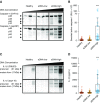Extracellular DNA, Neutrophil Extracellular Traps, and Inflammasome Activation in Severe Asthma
- PMID: 30888839
- PMCID: PMC6515873
- DOI: 10.1164/rccm.201810-1869OC
Extracellular DNA, Neutrophil Extracellular Traps, and Inflammasome Activation in Severe Asthma
Abstract
Rationale: Extracellular DNA (eDNA) and neutrophil extracellular traps (NETs) are implicated in multiple inflammatory diseases. NETs mediate inflammasome activation and IL-1β secretion from monocytes and cause airway epithelial cell injury, but the role of eDNA, NETs, and IL-1β in asthma is uncertain. Objectives: To characterize the role of activated neutrophils in severe asthma through measurement of NETs and inflammasome activation. Methods: We measured sputum eDNA in induced sputum from 399 patients with asthma in the Severe Asthma Research Program-3 and in 94 healthy control subjects. We subdivided subjects with asthma into eDNA-low and -high subgroups to compare outcomes of asthma severity and of neutrophil and inflammasome activation. We also examined if NETs cause airway epithelial cell damage that can be prevented by DNase. Measurements and Main Results: We found that 13% of the Severe Asthma Research Program-3 cohort is "eDNA-high," as defined by sputum eDNA concentrations above the upper 95th percentile value in health. Compared with eDNA-low patients with asthma, eDNA-high patients had lower Asthma Control Test scores, frequent history of chronic mucus hypersecretion, and frequent use of oral corticosteroids for maintenance of asthma control (all P values <0.05). Sputum eDNA in asthma was associated with airway neutrophilic inflammation, increases in soluble NET components, and increases in caspase 1 activity and IL-1β (all P values <0.001). In in vitro studies, NETs caused cytotoxicity in airway epithelial cells that was prevented by disruption of NETs with DNase. Conclusions: High extracellular DNA concentrations in sputum mark a subset of patients with more severe asthma who have NETs and markers of inflammasome activation in their airways.
Keywords: IL-1β; asthma; caspase 1; extracellular DNA; neutrophil extracellular traps.
Figures





Comment in
-
Functional Role of Inflammasome Activation in a Subset of Obese Nonsmoking Patients with Severe Asthma.Am J Respir Crit Care Med. 2019 May 1;199(9):1045-1047. doi: 10.1164/rccm.201903-0667ED. Am J Respir Crit Care Med. 2019. PMID: 30908928 Free PMC article. No abstract available.
References
-
- Krishnamoorthy N, Douda DN, Brüggemann TR, Ricklefs I, Duvall MG, Abdulnour RE, et al. National Heart, Lung, and Blood Institute Severe Asthma Research Program-3 Investigators. Neutrophil cytoplasts induce TH17 differentiation and skew inflammation toward neutrophilia in severe asthma. Sci Immunol. 2018;3:eaao4747. - PMC - PubMed
-
- Wright TK, Gibson PG, Simpson JL, McDonald VM, Wood LG, Baines KJ. Neutrophil extracellular traps are associated with inflammation in chronic airway disease. Respirology. 2016;21:467–475. - PubMed
-
- Kim RY, Pinkerton JW, Essilfie AT, Robertson AAB, Baines KJ, Brown AC, et al. Role for NLRP3 inflammasome-mediated, IL-1β-dependent responses in severe, steroid-resistant asthma. Am J Respir Crit Care Med. 2017;196:283–297. - PubMed
-
- Rossios C, Pavlidis S, Hoda U, Kuo CH, Wiegman C, Russell K, et al. Unbiased Biomarkers for the Prediction of Respiratory Diseases Outcomes (U-BIOPRED) Consortia Project Team. Sputum transcriptomics reveal upregulation of IL-1 receptor family members in patients with severe asthma. J Allergy Clin Immunol. 2018;141:560–570. - PubMed
Publication types
MeSH terms
Substances
Grants and funding
LinkOut - more resources
Full Text Sources
Other Literature Sources
Medical

